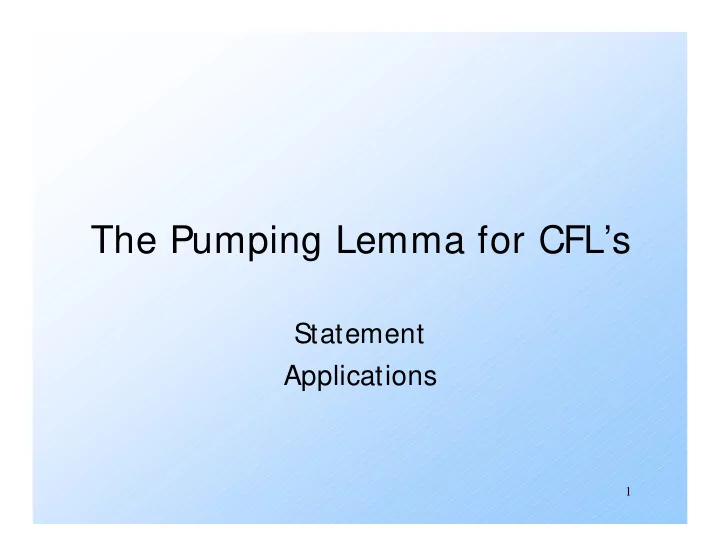

The Pumping Lemma for CFL’s Statement Applications 1
Intuition Recall the pumping lemma for regular languages. It told us that if there was a string long enough to cause a cycle in the DFA for the language, then we could “pump” the cycle and discover an infinite sequence of strings that had to be in the language. 2
Intuition – (2) For CFL’s the situation is a little more complicated. We can always find two pieces of any sufficiently long string to “pump” in tandem. That is: if we repeat each of the two pieces the same number of times, we get another string in the language. 3
Statement of the CFL Pumping Lemma For every context-free language L There is an integer n, such that For every string z in L of length > n There exists z = uvwxy such that: 1. |vwx| < n. 2. |vx| > 0. 3. For all i > 0, uv i wx i y is in L. 4
Proof of the Pumping Lemma Start with a CNF grammar for L – { ε } . Let the grammar have m variables. Pick n = 2 m . Let |z| > n. We claim (“ Lemma 1 ”) that a parse tree with yield z must have a path of length m+ 2 or more. 5
Proof of Lemma 1 If all paths in the parse tree of a CNF grammar are of length < m+ 1, then the longest yield has length 2 m-1 , as in: m variables one terminal 2 m-1 terminals 6
Back to the Proof of the Pumping Lemma Now we know that the parse tree for z has a path with at least m+ 1 variables. Consider some longest path. There are only m different variables, so among the lowest m+ 1 we can find two nodes with the same label, say A. The parse tree thus looks like: 7
Parse Tree in the Pumping- Lemma Proof Can’t both < 2 m = n because a be ε . longest path chosen A A u v w x y 8
Pump Zero Times A A A w u y u v x y w 9
Pump Twice A A A A A u v x y u v x y w v x w 10
Etc., Etc. Pump Thrice A A A A A u v x y u v x y w A v x v x w 11
Using the Pumping Lemma Non-CFL’s typically involve trying to match two pairs of counts or match two strings. Example: The text uses the pumping lemma to show that { ww | w in ( 0 + 1 )* } is not a CFL. 12
Using the Pumping Lemma – (2) { 0 i 10 i | i > 1} is a CFL. We can match one pair of counts. But L = { 0 i 10 i 10 i | i > 1} is not. We can’t match two pairs, or three counts as a group. Proof using the pumping lemma. Suppose L were a CFL. Let n be L’s pumping-lemma constant. 13
Using the Pumping Lemma – (3) Consider z = 0 n 10 n 10 n . We can write z = uvwxy, where |vwx| < n, and |vx| > 1. Case 1: vx has no 0’s. Then at least one of them is a 1, and uwy has at most one 1, which no string in L does. 14
Using the Pumping Lemma – (4) Still considering z = 0 n 10 n 10 n . Case 2: vx has at least one 0. vwx is too short (length < n) to extend to all three blocks of 0’s in 0 n 10 n 10 n . Thus, uwy has at least one block of n 0’s, and at least one block with fewer than n 0’s. Thus, uwy is not in L. 15
Recommend
More recommend